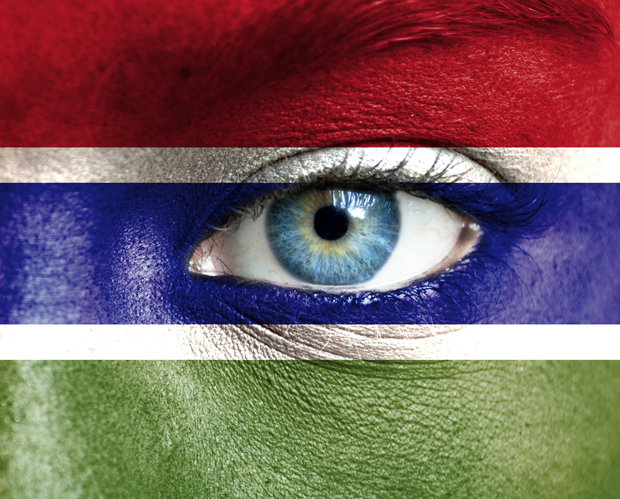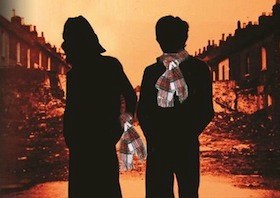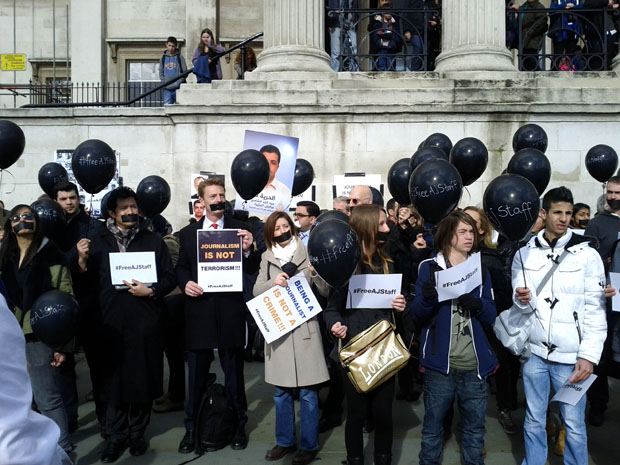6 May 2014 | Gambia, News

(Image: Shutterstock)
The campaign for media freedom in Gambia has lobbied the United Nations to take measures to address media freedom in the West African state. This comes amid a lingering struggle for freedom of expression and press freedom in the country, where over 110 journalists have gone into exile for fear of persecution.
Speaking at an event, journalist Omar Bah, author of the Africa Health on Earth, told delegates that journalism is the most dangerous profession in Gambia, adding there is the need for more awareness in the Gambian public to ensure divergent views for better democratic governance.
Bah, a survivor of torture who was presenting a paper on human rights, corruption, injustice and freedom of press, said: “We are way behind in terms of awareness due to censorship. If you write on a critical issue against the regime you are seen as inciting the people against the government.”
The Gambian writer said that in July 2013, the government directed the Public Utility Regulatory Authority to ban the use of free internet phone services using Voice over Internet Protocol (VoIP). Bah called this action a violation of press freedom. He added that the government said anyone using VoIP phone service was depriving the country of revenue from international and national calls and was therefore committing an economic crime. It subsequently stepped back from the ban but imposed stiff charges on internet cafes for use of VoIP.
He said the government pushed through legislation to impose sanctions on government officials and other individuals who give stories to Gambian online news outlets outside the country, with a penalty of a 15 year jail term or a fine of more than £47,000 for miscreants.
“I cannot imagine 110 journalists going into exile in small a country like Gambia, this shows how serious it is,” he stated. The figure is based on research conducted by the DOHA Centre for Media Freedom through the Dakar based inter-African Network for Women, Media, Gender Equality and Development, in collaboration with the International Federation of Journalists and the Gambian Press Union.
Bah also gave a vivid recollection of the 1999 media commission bill, the media amendment bill in 2004, the killings of Deyda Hydara, former co-proprietor and managing editor of the Point Newspaper, and Omar Barrow, former Sud FM Banjul reporter and Red Cross Volunteer, as well as the disappearance of former daily reporter Chief Ebrima Manneh, and torture of Musa Saidykhan.
“Media freedom has become worse in the Gambia, where there is too much arbitrary arrest, torture, killing and interference in the work of journalists, therefore, there is a need for a more global awareness on the issue to ensure that we have a free and vibrant media,” he concluded.
This article was posted on May 6, 2014 at indexoncensorship.org
6 May 2014 | News, Religion and Culture, United Kingdom

Julia Farrington travelled to Northern Ireland to participate in the 2014 Cathedral Quarter Arts Festival in Belfast. While there she saw four plays that deal with the Troubles as head of Sinn Féin, Gerry Adams, was questioned by police.
A new mural of Adams appeared on the Falls Road in West Belfast what seemed like only a matter of hours after he was taken into custody. Officially launched by Martin McGuiness to a crowd of thousands of Sinn Féin supporters on Saturday, and it was subsequently paint-bombed. The murals, far from being memorials to past struggles, are alive and kicking.
Across town in east Belfast, I went to Bobby “Beano” Niblock’s new play — Tartan at the Skainos Centre — passing the contentious murals of balaclava wearing Ulster Volunteer Force gunmen on the way. Niblock is a rare bird in Northern Ireland as loyalist voices continue to be massively under-represented in the theatre there. The play, though heavily laced with humour and raucously re-enacted 1970s hits, had a very dark message. It tells of betrayal within the loyalist community, as TC, the teenage leader of the Tartan street gang, is mentored, manipulated and ultimately murdered by older members of the community. The level of violence in Tartan completely chilled me; the young men graduating from what were seen as boys toys — crowbars, mallets and axes — to petrol bombs, guns and the crowning awe of a machine gun.
This play of street violence and male rite of passage, was the flip side of Flesh & Blood — three plays written, produced, directed and designed by women I had seen the previous day in a run through a week before they open at the Grand Opera House. I was invited by one of the playwrights, Jo Egan, whose play Sweeties revolves around the true story of a seemingly unperturbed victim of paedophilia and the devastation it causes her complicit friend. The other two plays were by comic genius Brenda Murphy and first time playwright and former leader of the Progressive Unionist Party, Dawn Purvis. All three tell stories centre on the experience of women and girls, firmly rooted in the domestic setting of home, street and neighbourhood; in the case of Sweeties, trapped by agoraphobia in a front room, or Dawn Purvis’ play through the eyes of a young girl, watching and commenting on life on her street, with the Troubles forming the backdrop. Brenda Murphy’s play was a deeply moving portrait of her mother’s struggle to bring up six illegitimate children who she had with a married man who lived around the corner.
Those three plays were so good to see. Women playwrights are strangely under-represented all over this country, when you compare to a much more equal landscape in fiction, biography and other written forms. But hearing those voices, the reality and humour of women in Belfast, a city which I found to be so acutely male dominated, was brilliant. I laughed and cried, and came away deeply affected by the lives I had seen on stage, the courage, compassion and humour of women left to deal with the fallout of male violence.
But in all cases the stage here is seeing untold stories, and in some cases unwelcome stories, coming to the surface; retelling, unearthing, revealing complex, individual stories that are hidden within the expression of communal identity of the murals.
This article was posted on May 6, 2014 at indexoncensorship.org
2 May 2014 | News

A London protest calling for the release of jailed Al Jazeera journalists in Egypt (Image: Index on Censorship)
Press freedom is at a decade low. Considering just a handful of the events of the past year — from Russian crackdowns on independent media and imprisoned journalists in Egypt, to press in Ukraine being attacked with impunity and government reactions to reporting on mass surveillance in the UK — it is not surprising that Freedom House have come to this conclusion in the latest edition of their annual press freedom report. This serves as a stark reminder that press freedom is a right we need to work continuously and tirelessly to promote, uphold and protect — both to ensure the safety of journalists and to safeguard our collective right to information and ability to hold those in power to account. On the eve of World Press Freedom day, we look back at some of the threats faced by the world’s press in the last 12 months.
1) Journalism is not terrorism…
National security has been used as an excuse to crack down on the press this year. “Freedom of information is too often sacrificed to an overly broad and abusive interpretation of national security needs, marking a disturbing retreat from democratic practices,” say Reporters Without Borders (RSF) in their recently released 2014 Press Freedom Index.
Journalists have faced terrorism and national security-related accusations in places known for their somewhat chequered relationship with press freedom, including Ethiopia and Egypt. However, the US and the UK, which have long prided themselves on respecting and protecting civil liberties, have also come under criticism for using such tactics — especially in connection to the ongoing revelations of government-sponsored mass surveillance.
American authorities have gone after former NSA contractor and whistleblower Edward Snowden, tapped the phones of Associated Press staff, and demanded that journalists, like James Risen, reveal their sources. British authorities, meanwhile, detained David Miranda under the country’s Terrorism Act. Miranda is the partner of Glenn Greenwald, the journalist who broke the mass surveillance story. Authorities also raided the offices of the Guardian — a paper heavily involved in reporting in the Snowden leaks.
2) …but governments still like putting journalists in prison
The Al Jazeera journalists detained in Egypt on terrorism-related charges was one of the biggest stories on attacks on press freedom this year. However, Mohamed Fahmy, Baher Mohamed, Peter Greste and their colleagues are far from the only journalists who will spend World Press Freedom Day behind bars. The latest prison census from the Committee to Protect Journalists (CPJ) put the number of journalists in jail for doing their job at 211 — their second highest figure on record.
In Bahrain, award-winning photographer Ahmed Humaidan was sentenced in March to ten years in prison. In Uzebekistan, Muhammad Bekjanov, editor of opposition paper Erk, is serving a 19-year sentence — which was increased from 15 in 2012, just as he was due to be released. In Turkey, after waiting seven years, Fusün Erdoğan, former general manager of radio station Özgür Radyo, was last November sentenced to life in jail. Just last Friday, Ethiopian authorities arrested prominent political journalist Tesfalem Waldyes and six bloggers and activists.
3) New media is under attack…
As more journalism is being conducted online, blogs, social and other new media are increasingly being targeted in the suppression of press freedom. Almost half of the world’s jailed journalists work for online outlets, according to the CPJ. China — with its massive censorship apparatus — has continued censoring microblogging site Sina Weibo, while also turning its attention to relative newcomer WeChat. In March, it closed down several popular accounts, including that of investigative journalist Luo Changping.
Meanwhile, Turkish Prime Minister Recep Tayyip Erdoğan has publicly all but declared war on social media, at one point calling it the “worst menace to society”. Twitter played a big role in last summer’s Gezi Park protests, used by journalists and other protesters alike. Only days ago, Turkish journalist Önder Aytaç was jailed, essentially, because of the letter “k” in a Tweet.
Meanwhile Russia has seen a big crackdown on online news outlets, while legislation recently passed in the Duma is targeting blogs and social media.
4) …and independent media continues to struggle
Only one in seven people in the world live in countries with free press. In many parts of the world, mainstream media is either under tight control by the government itself or headed up media moguls with links to those in power, with dissenting voices within news organisation often being pushed out. Brazil, for instance, has been labelled “the country of 30 Berlusconis” because regional media is “weakened by their subordination to the centres of power in the country’s individual states”. At the start of the year, RIA Novosti — known for on occasion challenging Russian authorities — was liquidated and replaced by the more Kremlin-friendly Rossiya Segodnya (Russia Today), while in Montenegro, has seen efforts by the government to cut funding to critical media. This is not even mentioning countries like North Korea and Uzbekistan, languishing near the bottom of press freedom ratings, where independent journalism is all but non-existent.
5) Attacks on journalists often go unpunished
A staggering fact about the attacks on journalists around the world, is how many happen with impunity. Since 1992, 600 journalists have been killed. Most of the perpetrators of those crimes have not been brought to justice. Attacks can be orchestrated by authorities or by non-state actors, but the lack of adequate responses by those in power “fuels the cycle of violence against news providers,” says RSF. In Mexico, a country notorious for violence against the press, three journalists were murdered in 2013. By last October, the state public prosecutor’s office had yet to announce any progress in the cases of Daniel Martínez Bazaldúa, Mario Ricardo Chávez Jorge and Alberto López Bello, or disclose whether they are linked to their work. Pakistan is also an increasingly dangerous place to work as a journalist. Twenty seven of the 28 journalists killed in the past 11 years in connection with their work have been killed with impunity. Syria, with its ongoing, devastating war, is the deadliest place in the world to be a journalist, while some of the attacks on press during the conflict in Ukraine, have also taken place without perpetrators being held accountable. That attacks in the country appear to be accelerating, CPJ say is “a direct result of the impunity with which previous attacks have taken place”.
This article was published on May 2, 2014 at indexoncensorship.org



